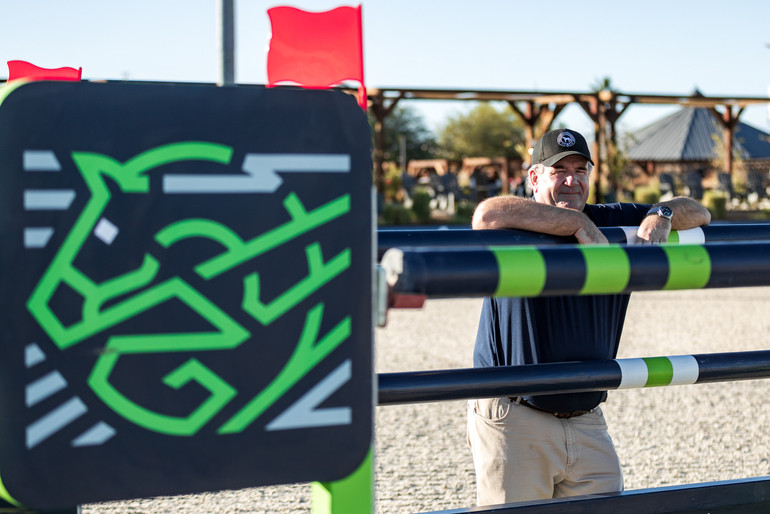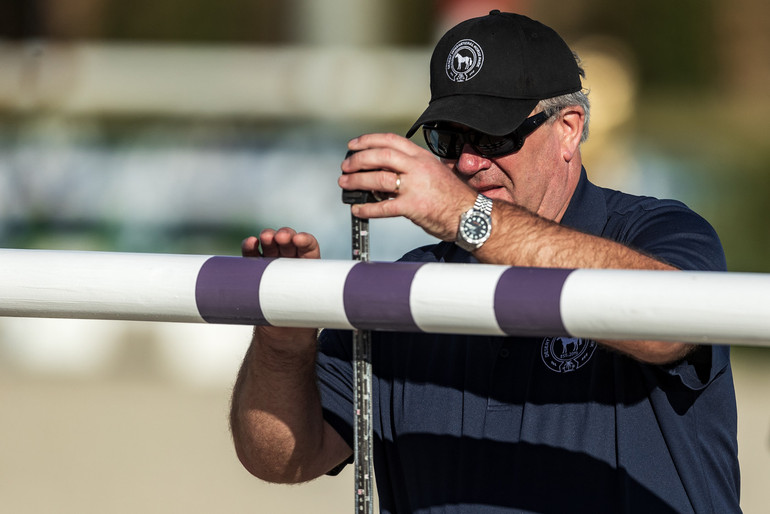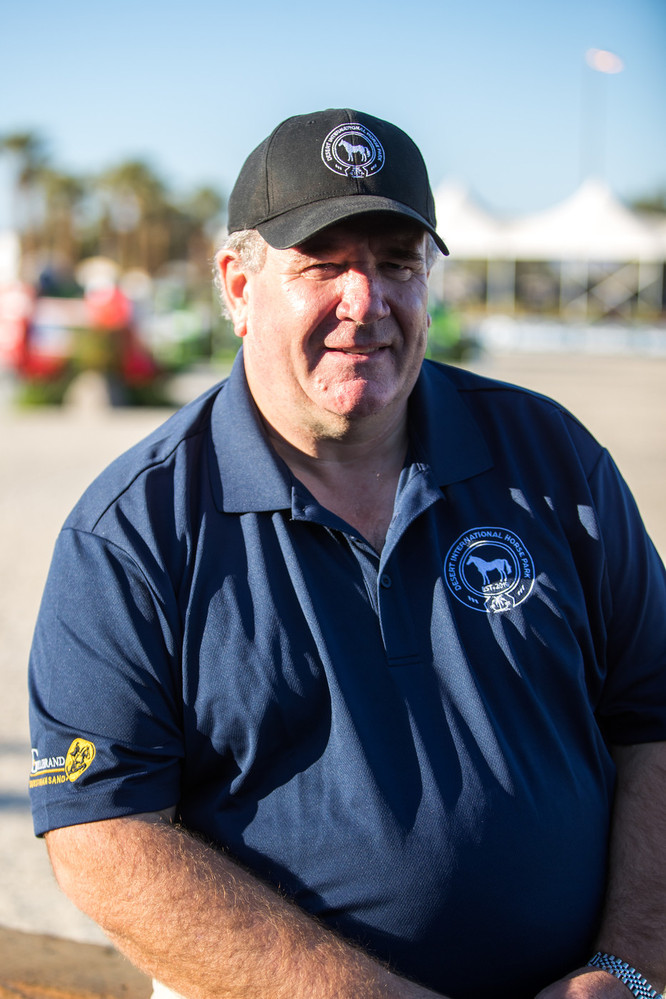 "I do enjoy course designing, for whatever level or standard it is for – the travel I am not a great fan of though. But, when I get to a show, there is fulfilment in the creation and execution of my course designs and I take great pride in the designs that we put in place," Alan Wade tells WoSJ. Photo © Spowart/Holm Equine Photography.
"I do enjoy course designing, for whatever level or standard it is for – the travel I am not a great fan of though. But, when I get to a show, there is fulfilment in the creation and execution of my course designs and I take great pride in the designs that we put in place," Alan Wade tells WoSJ. Photo © Spowart/Holm Equine Photography.
Text © World of Showjumping
At the 2018 World Equestrian Games in Tryon and the 2017 World Cup Final in Omaha, the courses were designed by Ireland’s Alan Wade. To World of Showjumping, the 52-year-old Irishman speaks about the complexities of being a course designer, how the Nations Cup series holds a special place in his heart and the importance of discussions in moving the sport forward.
Third generation horseman and course builder
Wade inherited his love for showjumping from his family, and especially from his father Tommy Wade. “My grandfather was a well respected horseman, and my father was an international rider whose wins included the Dublin Grand Prix, the Aga Khan Trophy, as well as the King George with the legendary Dundrum. Later on he was also a course designer,” Wade explains. “For many years, he was the Chef d’Equipe for the Irish team with over 30 victories in Nations Cup competitions. As a child, I followed along to the local shows in Ireland, where he would design courses – it all started from there. My father also had an interest in racehorses, and we had racehorses as well as showjumpers when I was growing up.”
“I was building courses and helping out at local shows from a young age, and as my interest grew, I followed it on,” Wade tells about his own career path. “I became a member of the Showjumping Association of Ireland and as soon as I was old enough, I joined the course designing panels. I moved up the ranks in the Irish system first, before moving out to international shows and getting to where I am now. I do enjoy course designing, for whatever level or standard it is for – the travel I am not a great fan of though. But, when I get to a show, there is fulfilment in the creation and execution of my course designs and I take great pride in the designs that we put in place. It has to be a 100% at every show, in every class.”
It has to be a 100% at every show, in every class
These days, Wade does about 20-25 shows per year, mostly in the States. “Lately, I have tried to do two weeks on, two weeks off,” he tells about his schedule. “Showjumping is a 12-month thing now, also for the course designers and officials – there are a lot more shows available all year around. I just need to be careful that I don’t overbook myself. I work for a company, Clareen Equestrian Ltd., so we can be mindful with what we accept. However, it is always an honour to be asked to go and design somewhere new. I am always open to new shows, but I am more than happy with what I have achieved so far.”
Even though Wade started his career in Ireland, he has ended up working mostly in the States. “It was through contacts and meeting people, and doing good course designing I assume,” he explains. “I had assisted at shows in Europe with Brian Henry, Bob Ellis and Frank Rothenberger when Linda Allen gave me a contact in the States. My first show was in Roanoke VA. I went to Tampa to assist Bob Ellis and then to Wellington for Michael Morrissey – that is how it started. Annually, I do one or two shows in Europe, Canada and a few in Mexico as well – but mostly my designs are created for shows in the States.”
Not as simple as it may seem
There are many challenges in the work of a course designer, Wade points out. “Personally, I believe it is about challenging yourself; as a course designer, you are trying to get good sport, while looking after the horses,” he says. “All courses should be created with the welfare and safety of the horse as the most important factor. You should design a course that is jumpable and still creates a level of sport that is suitable for whatever event it is – whether it is a local show in Ireland or a five-star Grand Prix.”
“Most people in the sport are probably really appreciative of our job,” Wade continues. “However, there is always pressure on the course designers. We are trying to do the job correctly, but in the end, we are all human. Some people think it is very easy; just go out and put a few fences here and there. I don’t think they really understand – there is a lot of variables that influences a class. As a course designer, all you want is to have a good arena with a nice surface, nice fence material and a good team of people to help you. When you get to the bigger shows, you have sponsor fences that must be placed, interviews that have to be done, press conferences to visit – there are a lot of moving parts that you have to try and manage, and manage in a good way, to get good sport and to put the best possible courses out there. It is definitely not simple to do a good job.”
All courses should be created with the welfare and safety of the horse as the most important factor
Wade believes that growing up surrounded by horses helps him in his work. “When designing a course, you also need to have a “feeling” for the level of competitors that you have. You must watch closely to assess what the standard is and design suitable courses for that level,” he explains. “At the end of the day, as a course designer, you are trying to create courses which produce good sport. I was brought up with horses all my life and thanks to that, I can make quick judgements about them. When I go to a new place where I might not have seen some of the competitors or some of the horses, I can make up my mind about the standard of the competitors and horses quickly. Based on these judgements, I fine tune my designs accordingly.”
“I do understand the difficulties that all course designers have to go through,” Wade continues. “There is an increase in technicalities, the responsibilities and the requirements that course designers have to deal with. Therefore, I don’t comment on other course designers’ work. The fact is that I rarely get to see other course designers in action.”
No place like Dublin
Wade has worked at many prestigious events, but when it comes to naming a personal highlight from his long and successful career, the answer hits near home. “Dublin, of course,” he says. “To be asked to design in the main ring for the first time in 2009 was the pinnacle of my career at that stage. It is the Irish that invented showjumping; the first ever showjumping event was held in Ireland many, many years ago – and Dublin is the biggest event of the year for the Irish.”
I love doing Nations Cups
“The way I was brought up, the Nations Cup was the corner stone of the sport,” Wade continues. “For every Irish showjumping fan, the Aga Khan Friday in Dublin was THE day of the year. If you go anywhere in the world, there will be Irish riders in the prize giving of the Grand Prix, but I believe that the main focus for any Irish rider would be to represent their country, in Ireland, on the Aga Khan day. Especially with my father having won the Aga Khan both as a rider and Chef d’Equipe, the Nations Cup was the focus of every week. As a course designer, I have been lucky enough to have designed Dublin eight or nine times. I am honoured to have designed the Nations Cup in USA on a number of occasions, I have designed Rotterdam, SIEC Istanbul – my first CSIO was the Bosphorus International Horse Show, Abu Dhabi, Lisbon, Rabat… and I love doing Nations Cups. For me, of all the competitions, those are the ones I enjoy the most.”
While Dublin is Wade’s favourite, the creativity when working at a championship is on another level, he tells. “The first championship I was asked to do was the World Cup Final in Omaha in 2017. Being from Ireland, it was a huge honour that the organisers asked me and trusted me to do the job. What makes championships so special, is that as a course designer, you get the chance to design the fences and create different fence ‘fill’ and colours. You can have exactly the fence material that you want. The fact that you can control the fence material up to a certain degree – with budget limitations of course – is exceptional. A lot of the shows now have sponsor fences that you must include, but at a championship, you can get creative. For Tryon, together with Steve Stephens, we tried to create looks, fences and courses that followed my ethos, that I was happy with, and at the same time gave good results for the sport.”
Moving forward through discussion
“There should always be discussion,” Wade says when we move on to speak about the future of the sport as a whole. “The FEI consists of officials, athletes, horses, the whole lot, and we should always try to keep the sport moving forward. I would like to see the FEI put more emphasis on the Nations Cup series. That has been my focus growing up and I think as prize money has risen in so many individual classes, we should up the prize money in the Nations Cup series as well. The easiest way to promote something nowadays is money. The riders might not have liked the formats of some other shows, but money has made them work around it. If the Nations Cup series is the corner stone of FEI Jumping, surely we need to find a way of keeping it on top also in terms of prize money.”
“Looking back, having the old Nations Cup format is very easy for the public to watch and follow,” Wade continues. “I was lucky enough to be involved in the 2012 Olympics in London with Bob Ellis, who is a good friend, and I think that was the best sport we have seen at the Olympics in the last number of years. I don’t think anyone can disagree when they look back. Why move away from something that provided something so good? There is a saying; ‘if it ain’t broke… why fix it?’ The sport in London was top, and in my opinion, the new format in Tokyo definitely did not work.”
I would like to see the FEI put more emphasis on the Nations Cup series
In 2022, the time penalty regulations came under discussion after being changed at the beginning of the year. “Personally, when I think about it, what difference does the new rule create?” Wade asks. “In the end, clear rounds will finish in front of time penalties – whether it is one or four – in all FEI Table A classes. For me as a course designer, the discussion about getting one or four penalties does not make a difference; it is only about a difference in the placement down the line anyway, it is only a number. However, I do believe that any changes in rules – and we should be trying to simplify the rules – should be suitable for all levels, worldwide.”
“As a course designer, I don’t see how the new time penalty regulations affect our work – you should still be measuring the courses the same way as you did before. For me, the rule is only about the number you give to a time fault, nothing more. The length of the course is still the length of the course, and the speed is the speed that is listed in the schedule. For young horses, the speed is and should be less. For someone who measures their course physically with a wheel, it does not really affect what distance the actual course will be. There is only one distance for any correctly measured course and the number of penalties a rider gets for exceeding the time allowed is not in the back of my mind when I am measuring the course – I am just trying to get the correct length. For me, there are other things in the sport that should be discussed more than time penalties.”
There are other things in the sport that should be discussed more than time penalties
“The correct measurement of the course is not as simple as it may seem though; you have to take into account the line, turns, etc. – there are many variables that come into play,” Wade continues. “In any major Grand Prix, I measure the course four times at a minimum, and my assistant will be measuring it as well, and still, you can never really say to a 100% that you know you will have the correct time allowed. However, that is what we are trying to do. You have to be consistent as a course designer and produce a time allowed that has an influence but that doesn’t over-influence any competition. It is not simple though, to get the time allowed right.”
Looking forward
“The problem with the future is that you need to be proactive,” Wade points out. “I did not even know the time penalty regulations were on the table, but that is just me, too busy designing. Riders, maybe if they knew what was on the table, they could react earlier. For four years, 2014-2017, I was the elected representative for the course designers to the FEI through the Jumping Committee. During that time, at the end of each year, I used to email every level four course designer around the world and ask them if there was anything they wanted to know about or anything they felt should be put forward. Each year, I sent the feedback through to the Jumping Committee. Some of the issues I might not have agreed on, but if a course designer took their time to respond, I would put it forward."
Democratic consultation with all the stakeholders is always necessary
"I feel as course designers, we are dealing with the rule changes day to day, and if a rule isn’t working that well, we are the first to try and work with it. Therefore, I think there should be more communication. It is better to have the discussion before the rule change rather than after. However, all discussion is good. The FEI is trying to push the sport forward in the way that they believe is the best way, but democratic consultation with all the stakeholders is always necessary,” Wade closes off.
11.1.2023 No reproduction of any of the content in this article will be accepted without a written permission, all rights reserved © World of Showjumping.com. If copyright violations occur, a penalty fee will apply.










